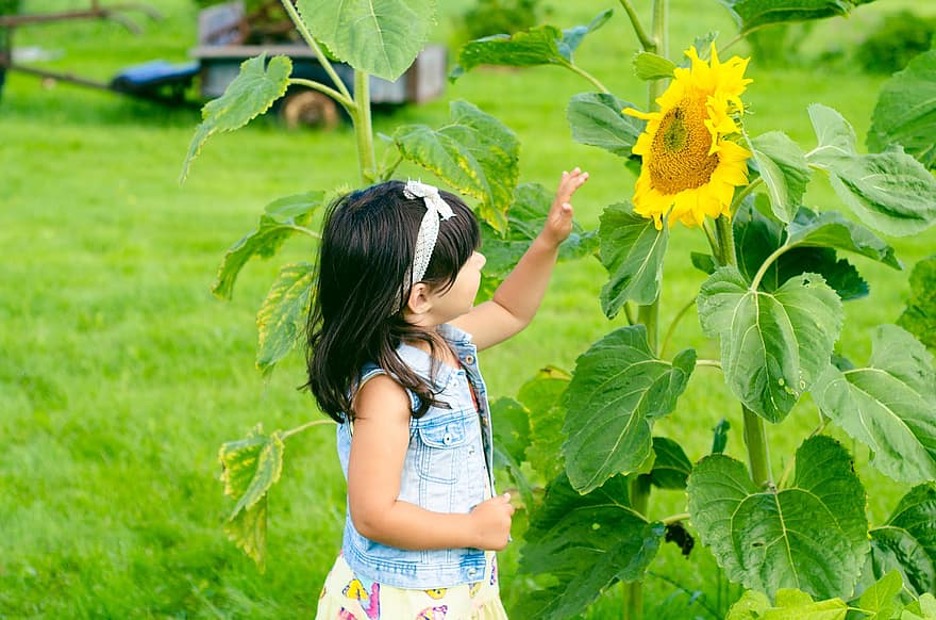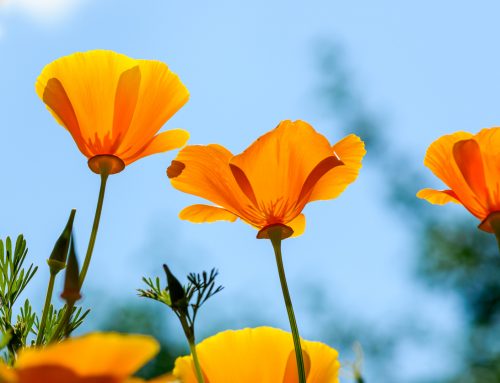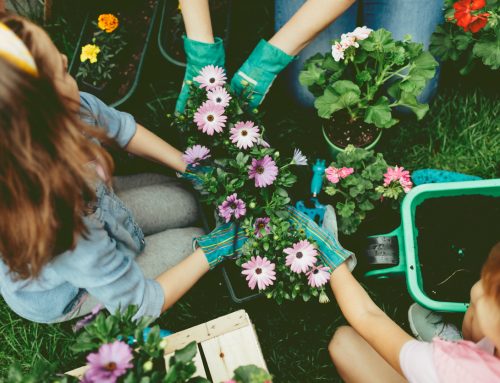All flowers make us happy when we see them in a beautiful bouquet or growing in the garden, but…
few make us smile more than the magical sunflower! At botanic gardens, sunflowers flourish in wildflower meadows and are the perfect way to introduce children to the wonders of nature. The sunflower symbolizes optimism, positivity, long life and happiness, so it’s no wonder that the National Garden Bureau has named 2021 the Year of the Sunflower.
There are many unique aspects of the sunflower that never fail to fascinate, but probably the most fascinating is that as young plants, their faces follow the sun from sunrise to sunset, every day, repeating this cycle until maturity, a behavior called “heliotropism”. Once they mature, they face east which allows them to attract up to five times more pollinators because they warm up faster than westward facing plants.
Sunflowers are a stunning addition to the garden, ranging in height from 2 ft. to 9 ft., but they are more than just a pretty face! They also provide great benefits beyond their appearance. Within the sunflower “face”, there are hundreds of other tiny blooms full of pollen and nectar which attract bees and butterflies who provide good pollination for plants around them. Their abundance of seeds (a single sunflower can have up to 2,000 seeds) are also attractive to birds. They also help improve soil health and fertility because they have a single root that can extend up to 5 feet underground, which helps break up compacted soil and improves the soil structure. And their root system allows them to access water and nutrients far below the soil surface so they require little or no supplemental water or fertilization.
 With so many beautiful varieties of sunflowers, with colors ranging from the classic bright yellow, to orange, deep reds, and even purple, it’s hard to pick a favorite. But my vote would be for a newer annual variety that is a prolific bloomer called SunBelievable Brown Eyed Girl from Monrovia Nursery. It is not the characteristic large bloom at the top of the stem, but is more compact with multiple stems and countless bright yellow blooms. It gets its name of “SunBelievable” because of the amazing number of blooms it produces compared to the traditional sunflower, and the name “Brown Eyed Girl” from the dark brown center with a mahogany-colored ring around it. And with the added bonus that it blooms continually from spring until fall, and is heat and drought tolerant, it’s definitely a favorite pick for the garden.
With so many beautiful varieties of sunflowers, with colors ranging from the classic bright yellow, to orange, deep reds, and even purple, it’s hard to pick a favorite. But my vote would be for a newer annual variety that is a prolific bloomer called SunBelievable Brown Eyed Girl from Monrovia Nursery. It is not the characteristic large bloom at the top of the stem, but is more compact with multiple stems and countless bright yellow blooms. It gets its name of “SunBelievable” because of the amazing number of blooms it produces compared to the traditional sunflower, and the name “Brown Eyed Girl” from the dark brown center with a mahogany-colored ring around it. And with the added bonus that it blooms continually from spring until fall, and is heat and drought tolerant, it’s definitely a favorite pick for the garden.
If you want to grow sunflower plants, they are relatively easy because they are heat tolerant, pest resistant and fast-growing, and they can adapt to conditions in most locations. Whether you want to use them in cut flower arrangements, for welcoming displays in your garden, or harvesting them to eat their seeds…
Here are some useful tips:
- Locate them in a spot that gets six to eight hours of direct sun per day;
- Plant them in soil that is loose and well draining so that their long tap roots can grow uninhibited several feet below the soil surface;
- Enrich the soil with compost or other organic matter mixed into it to ensure that they will be healthy and generate a lot of blooms;
- Once the plant is established, water infrequently, but deeply to encourage deep root growth;
- If you want to grow sunflowers in pots, choose a smaller variety and make sure the pot is deep enough for their tap root. If growing a taller variety in the ground, try to plant them in a sheltered location or next to a fence to protect them from the wind; and
- You can grow sunflowers from starter plants or seeds (usually allows more varieties to choose from). You can plant seeds between March and May, and if you want to have continuous blooms, you can stagger the plantings every two to three weeks.
- When using cut sunflowers in an arrangement, make sure to cut off the bottom inch of the stem at an angle while the stem is submerged in water, then transfer them to a vase with room temperature water and a plant food solution. Replacing the water in the vase every 1 to 2 days will extend the life of the sunflowers, and if their heads get a little droopy, revive them by re-cutting the stems and adding a few teaspoons of sugar to the water.
Whether you choose to plant sunflowers in your own garden, or admire them in open fields? their unique charm will never fail to bring a smile to your face. California’s native Common Sunflower thrives in open spaces and would be a perfect choice for planting in a future Great Park Botanical Garden. Want to snap some amazing photos of your family in a sunny sunflower meadow? Want to lose yourself in a maze of sunflowers? Let Irvine City Council know you’re ready for adventure! Send an email to: irvinecitycouncil@cityofirvine.org








